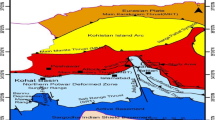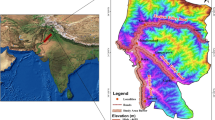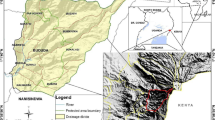Abstract
The present work is focused on the distribution of landslides in Foglia River basin (central Italy), using a heuristic approach supported by GIS tools for the construction of statistical analysis and spatial data. It aims to investigate any dependencies and/or relationships between natural factors related to the study area and landslides. In the study area, 2821 landslides were surveyed covering a total area of 155 km2 that corresponds to 22% of the entire basin. The findings of the study highlight the importance as well as the role of individual factors, such as lithology, land use, orientation, and slopes, which led to the development of landslides analyzed.
Access provided by Autonomous University of Puebla. Download conference paper PDF
Similar content being viewed by others
Keywords
1 Introduction
In the last decades, landslide events have been a recurring problem with increasing frequency in all areas of the Italian peninsula. In particular, the development and spreading of landslide events throughout the national territory have shown a clear increase in the costs of restoration work, protective measures, and damage caused to infrastructure and production activities by landslides and costs that have gained more weight in the national public budget. This evidence accounts for the need to develop studies of prediction and prevention of landslides and their risks. These studies can be performed by correlating information from different geographic areas with limited use of resources to run them on a large scale. Studies about landslides distribution, such as on the landslide susceptibility, are greatly influenced by the degree of detail required and by the availability of data, which is often directly proportional to the budget. The most common approaches in the literature are called heuristics. They apply the “cause and effect” instance to evaluate the intrinsic parameters, which are classified and valued on the basis of evaluations, sometimes arbitrary, to favor or not the landslides event (Atkinson and Massari 1998). Other approaches are of statistical nature. They aim to identify a set of variables based on available data. This approach is widely used, as well as that of the multivariate. For several years, the GIS was considered a reference tool for the study of landslides and more generally, as a tool for assessment of spatial relationships of landslide phenomena in a study area (Lan et al. 2004; Ayalew and Yamagishi 2005). Taking that into consideration, many factors that play a role in the development of landslides can act in different ways and combination in relation to the type of landslide and environmental conditions (Brunsden 1996). The present work is focused on the distribution of landslides in the Foglia River basin area located in the Adriatic side of the Northern Apennines, using a heuristic approach, supported by GIS tools for the construction of statistical analysis and spatial data.
The study aims to identify the possible existence of relationships between the natural factors illustrated above and landslides. To this end, the study of landslide distribution was carried out by superimposing each thematic map previously created with the landslides surveyed to recognize any possible direct relationship of cause and effect.
2 Materials and Methods
The data collected in this study represent the different parameters that can influence or can be involved in the development of landslides. The data were analyzed through available public cartographic documents and integrated by existing aerial images. In a second step, the data were organized and structured in GIS themes, then grouped into seven categories. All data acquisition, digitization, data entry, processing, and analysis were conducted using a GIS (ArcView 3.2 by ESRI). The topographic map provided information on the slope, altitude, and orientation (scale 1:10,000, available in vector format). It was also possible to extract contour and spot elevations. Then, a digital terrain model (DTM) was elaborated developing a triangular irregular network (TIN). Later, the DTM was resampled in a digital elevation model (DEM) with a square m network with side of 250 m. (the software was used by ThreeX Terranova). The parameters considered are summarized below:
-
(a)
Landslides: The landslides recorded within the study area were surveyed using the landslide inventory prepared by the “Autorità di Bacino delle Marche,” which uses data from municipality integrated with data from other projects, such as CARG (new geological map 1: 50,000) and IFFI Landslide Inventory Map (GNDCI). Data were homogenized by applying the classification by type of phenomena and processes (Hungr et al. 2014). The following step was to verify the data through field survey and analysis of aerial photographs using a tablet pc (see Fig. 1). The landslides were finally cataloged to scale 1:10,000.
-
(b)
Lithology: The data used to classify the lithologies outcropping in the study area were available from the geological map scale 1:25,000 (N. 109 and 108 of the Official Italian Geological Map).
-
(c)
Land use: The data related to land use within the study area were obtained using the existing maps (1:10,000 scale map of land available in vector format), suggesting that the Foglia River basin can be divided into five major classes.
-
(d)
Slope: The slopes displayed by the Foglia River basin were not very steep slopes, but rather concentrated between 0 and 20°. They were found in 94% of the entire basin. Nevertheless, a detailed analysis was conducted, by grouping the frequency of landslide in classes of 2° of the slope.
-
(e)
Orientation of the slope: This parameter was considered of interest because in the study area and its surrounding region, the exposure factor was always considered an important element in the morphological evolution of the landscape.
3 Results
A total of 2821 landslides were surveyed in the study area. About 1886 of these landslides were classified as debris flow (DB), 10 as rockfalls (RF), 25 as deep-seated gravitational slope deformations (DGSD), 144 as complex landslides (CL), 492 as slides (rotational and translational) landslides (SS), and 264 as solifluction flows (SF). The landslides surveyed occupied a total area of 155 km2, corresponding to 22% areal extent of the entire basin.
3.1 Landslides and Lithology
Landslides were widely distributed mainly on deposits characterized by pelitic formations (30.5%), and marl arenaceous formations (29.7%), and to a lesser extent, on the deposits characterized by sandstone formations (9.6%).
3.2 Landslides and Land Use
The land use did not seem to provide any particular indications, given that landslides were distributed on all types of classes. In fact, the analysis of the 6 classes that comprise 97% of landslides did not seem to highlight any relations.
3.3 Landslides and Slope
In relation to the slope, the analyzed data showed: (i) 13.7% of landslides occurred on slopes of less than 6°, (ii) 70.7% of landslides occurred in the range of slope between 6° and 16°, and (iii) 15.6% of the phenomena were distributed in the classes with a slope greater than 16°. As for slopes >30°, only 0.042% of the events could be observed.
3.4 Landslides and Altitude
The distribution of landslides indicated their presence in all classes examined, highlighting an absolute maximum value of 32.58% in correspondence of the altitude 150–300 m and value of 27.89% in the class 300–450 m.
3.5 Landslides and Orientation of the Slope
The data suggested that the maximum frequency of landslide records was to NE. In fact, it was generally higher in areas exposed to the north than those exposed to south. The lower slope classes (0–5° and 5–10°) were characterized by a similar landslides’ frequency between areas with north and south orientation. Whereas in the upper slope classes, landslides frequency was higher in areas exposed to north.
4 Discussion and Concluding Remarks
Our results cast a light on the factors and their roles in contributing to the development of landslides in this area. The data analysis revealed the following insights on the study area: (a) Overall, the lithology was an important factor in controlling landslides. It was suggested that the marl and clay lithologies were very susceptible to the landslide. (b) The slope parameter showed an apparent correlation between the distribution of landslides and slope classes, highlighting the absence of direct proportionality between the increase of the slope and rise of the phenomena. (c) The exposure parameter did not influence the development of landslides, although they were generally more prevalent in the quadrants of north compared to those of south. Furthermore, this methodology could be applied to all orders of magnitude scale, needing limited resources both from an economic and a human point of view.
References
Atkinson, P.M., Massari, R.: Generalized linear modeling of susceptibility to landsliding in the central Apennines Italy. Comput. Geosci. 24, 373–385 (1998)
Ayalew, L., Yamagishi, H.: The application of GIS-based logistic regression for landslide susceptibility mapping in the Kakuda-Yahiko mountains, Central Japan. Geomorphology 65, 15–31 (2005)
Brunsden, D.: Mass movement, the research frontier and beyond: a geomorphological approach. Geomorphology 7, 85–128 (1996)
Hungr, O., Leroueil, S., Picarelli, L.: The Varnes classification of landslide types, an update. Landslide 11(2), 167–194 (2014)
Lan, H.X., Zhou, C.H., Wang, L.J., Zhang, H.Y., Li, R.H.: Landslide hazard spatial analysis and prediction using GIS in the Xiaojiang watershed, Yunnan China. Eng. Geol. 76, 109–128 (2004)
Author information
Authors and Affiliations
Corresponding author
Editor information
Editors and Affiliations
Rights and permissions
Copyright information
© 2022 The Author(s), under exclusive license to Springer Nature Switzerland AG
About this paper
Cite this paper
Baioni, D. (2022). Landslide Distribution Analysis in the Foglia River Basin, Northern Apennines, Italy. In: Çiner, A., et al. Recent Research on Geomorphology, Sedimentology, Marine Geosciences and Geochemistry. CAJG 2019. Advances in Science, Technology & Innovation. Springer, Cham. https://doi.org/10.1007/978-3-030-72547-1_13
Download citation
DOI: https://doi.org/10.1007/978-3-030-72547-1_13
Published:
Publisher Name: Springer, Cham
Print ISBN: 978-3-030-72546-4
Online ISBN: 978-3-030-72547-1
eBook Packages: Earth and Environmental ScienceEarth and Environmental Science (R0)





